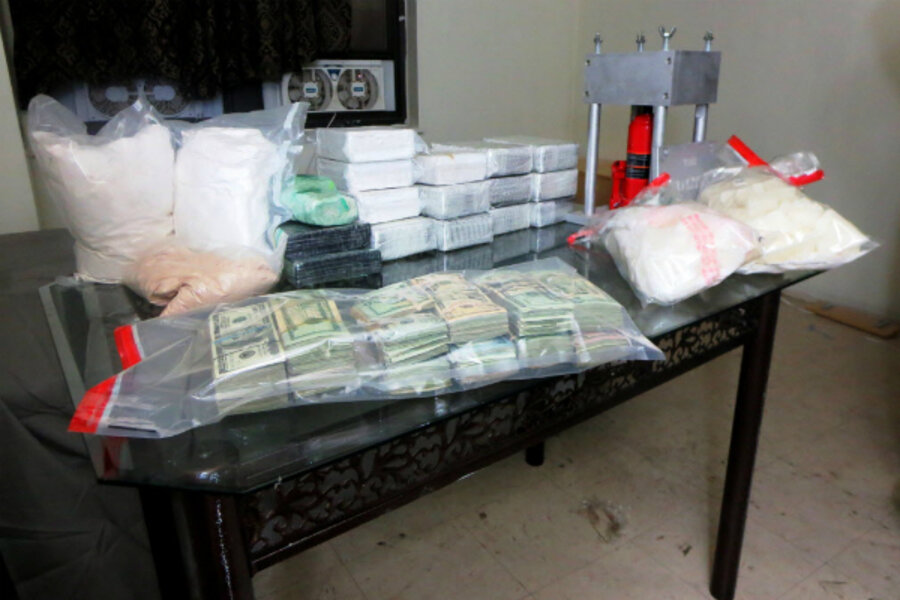New York heroin seizures mark surging epidemic, new suburban users
Loading...
| NEW YORK
When actor Philip Seymour Hoffman died in early February from an overdose of heroin, America turned its attention toward the growing use of the infamous opiate throughout the US – especially in white suburbia, areas far from the stereotype of the shivering urban junkie.
Overall heroin use has nearly doubled in the past five years – there were nearly 670,000 users reported in 2012, up from 373,000 in 2007, according to the National Survey on Drug Use and Health. But this surge in US demand, of course, requires a corresponding growth in the shadowy networks supplying one of the world’s most addictive and dangerous drugs.
The hub of many of these networks, law enforcement officials say, is New York City, where Hoffman overdosed in his Greenwich Village apartment. Like merchants peddling other commodities, legal and not, drug cartels from Mexico truck the drug into the city to be processed and packaged, officials say, then sell it to the nation’s largest local market – while also easily distributing packets throughout the region.
“What we’re seeing here in New York City is dual problem,” said New York’s special narcotics prosecutor, Bridget Brennan, on Tuesday, testifying before the City Council. “We have a problem in that New York City has been become the hub of regional distribution of heroin throughout the Northeast.
“But what we’ve also seen, and that is equally troubling, is a new user group emerging,” Ms. Brennan continued. “And that is young people, people who are middle class, blue collar, people who have a higher education level than those we have previously seen.”
As a result of this continued surge, city and federal drug agents are taking more heroin off the streets than they have in 20 years. So far, drug agents have seized 288 pounds of heroin from traffickers in New York this year, worth from $40 million to $60 million, officials say. In all of 2013, officials seized a total of 175 pounds in New York City.
“What we have seen thus far this year has eclipsed anything that we’ve seen since we started keeping records in 1991,” Brennan told the City Council.
On Monday, law enforcement officials announced that they had busted a multimillion-dollar heroin ring based in the Bronx, when they seized more than 50 pounds of the drug in Hartford, Conn., worth about $11 million, in a two-city sting last week. US Drug Enforcement Administration (DEA) agents and the New York Police Department, working together, also seized $85,000 in cash, as well as 20 pounds of cocaine and a number of assault rifles, raiding two Bronx apartments as well.
“These seizures and arrests demonstrate that NYC is Ground Zero of heroin distribution networks supplying the Northeast, as well as being the prime market Mexican drug traffickers are using to earn profit from the sale of poison,” said James Hunt, acting special agent in charge of the DEA's New York Division, in a statement.
As the Monitor reported in March, much of this surge can be attributed to economics: Heroin is now cheaper and more readily available than the kinds of prescription opiates more commonly abused in the past, especially in suburbs.
The new group of users reported by Brennan has also been noticed throughout the country – as has been widely reported for the past few months. This week, a prosecutor in southwest Ohio, Michael Gmoser, reported that his phone has been ringing off the hook since he announced last Thursday that he wanted to hear from suburban heroin users as he educated himself about his region's epidemic and looked for ways to combat the problem.
Officials in Vermont and Massachusetts have also brought attention the growing problem among new users.
“Often they start with prescription drug abuse, abusing painkillers, and then when those painkillers become too expensive, they turn to heroin,” Brennan testified. She also noted that the city’s long-term urban hotspots were also seeing skyrocketing use, as prices have fallen as the drug saturates the market.
Not only is heroin cheaper now, bit it also is becoming much more pure, leading to a lethal rise in overdoses, officials say. Between 2010 and 2012, heroin overdoses were up 84 percent in the city.
The heroin being seized by New York officials is about 40 to 60 percent pure, Brennan said. By comparison, the heroin available in the deadly epidemic of the 1970s was 6 to 10 percent pure.
“And so the new users are snorting heroin, because they can get an effective high much more quickly rather than turning toward the needles,” she said. “The needles that might have scared users away are not being used during the initiation stage, as they were in previous years.”
While New York has always been a hotbed of heroin use and a major distribution point for traffickers, the recent surge has exacerbated both. New York DEA agents have seized about 35 percent of total heroin intercepted by the agency since October – compared with about 20 percent of nationwide DEA seizures in previous years.
“It’s cheap, it’s potent and there’s a user demand here right now and they’re flooding the market,” said DEA Special Agent Hunt, according to The New York Times. “In my time, we’ve never seen the amount of large heroin seizures like this.”






